Structure–Property Correlation between Friction-Welded Work Hardenable Al-4.9Mg Alloy Joints
Abstract
:1. Introduction
2. Experimental Materials and Methods
2.1. Parent Metal
2.2. Welding Details
2.3. Metallographic Examination
2.4. Mechanical Testing
3. Results and Discussion
3.1. Base Metal Microstructure
3.2. Microstructure of Weld-Interface
3.3. Mechanical Properties
4. Conclusions
- Analysis using optical and electron microscopy revealed the presence of flawless welds of high quality, devoid of any defects such as cracks or porosity.
- Close to the weld interface, two distinct microstructural zones were identified: the dynamically recrystallized zone (DRZ) and the thermomechanically affected zone (TMAZ). The process of rotary friction welding caused significant plastic deformation in the DRZ, resulting in grain refinement. The recrystallized zone exhibited fine equiaxed grains with an average size of 5 ± 2 μm, while the TMAZ was characterized by elongated grains.
- A notable increase in hardness was observed along the recrystallized zone (DRZ) of the weldment. This enhancement can be attributed to the formation of refined grains during the welding process.
- The tensile test specimen failed within the heat-affected zone (HAZ) of the weldment, indicating the superior strength of the weld interface compared to the base metal and HAZ. The weldment demonstrated higher tensile values (YS: 301 ± 6 MPa; UTS: 425 ± 7 MPa) compared to the base metal (YS: 207 ± 5 MPa; UTS: 385 ± 9 MPa). The increased strength of the weldment can be attributed to the presence of fine equiaxed grains in the DRZ.
- The tensile graph of the BM displays serrations across the curve, which is attributed to a common phenomenon in Al-Mg alloys known as the Portevin–Le Chatelier effect (serrated yielding). This effect is generally caused by the influence of dynamic strain aging on the macroscopic plastic flow of the material.
- The weldment exhibited a slightly lower percentage of elongation (%El: 13 ± 2) compared to the base metal (%El: 15 ± 3). This decrease in ductility can be attributed to the formation of distinct weld zones within the welded sample.
Author Contributions
Funding
Data Availability Statement
Acknowledgments
Conflicts of Interest
References
- Mathers, G. The Welding of Aluminum and Its Alloys; Woodhead Publishing Ltd.: Cambridge, UK, 2002. [Google Scholar]
- Wahid, M.A.; Siddiquee, A.N.; Khan, Z.A. Aluminum Alloys in Marine Construction: Characteristics, Application, and Problems from a Fabrication Viewpoint. Mar. Syst. Ocean Technol. 2020, 15, 70–80. [Google Scholar] [CrossRef]
- Kaufman, J.G. Introduction to Aluminium Alloy Tempers; ASM International: Materials Park, OH, USA, 2000. [Google Scholar]
- Sielski, R.A. Research Needs in Aluminum Structure. Ships Offshore Struct. 2008, 3, 57–65. [Google Scholar] [CrossRef]
- Olson, D.L.; Siewert, T.A.; Liu, S.; Edwards, G.R. Welding, Brazing, and Soldering; ASM International: Materials Park, OH, USA, 1993. [Google Scholar]
- Samiuddin, M.; Li, J.; Taimoor, M.; Siddiqui, M.N.; Siddiqui, S.U.; Xiong, J. Investigation on the Process Parameters of TIG-Welded Aluminum Alloy through Mechanical and Microstructural Characterization. Defence Technol. 2021, 17, 1234–1248. [Google Scholar] [CrossRef]
- Praveen, P.; Yarlagadda, P.K.D.V. Meeting Challenges in Welding of Aluminum Alloys through Pulse Gas Metal Arc Welding. J. Mater. Process. Technol. 2005, 164–165, 1106–1112. [Google Scholar] [CrossRef]
- Torok, I.; Juhasz, K.; Meilinger, A.; Balogh, A. Main Characteristics of Fusion and Pressure Welding of Aluminium Alloys. Metals 2012, 2, 91. [Google Scholar]
- Cetinel, H.; Ayvaz, M. Microstructure and Mechanical Properties of AA 5083 and AA 6061 Welds Joined with AlSi5 and AlSi12 Wires. Mater. Test. 2014, 56, 884–890. [Google Scholar] [CrossRef]
- Babu, N.K.; Talari, M.K.; Pan, D.; Sun, Z.; Wei, J.; Sivaprasad, K. Microstructural Characterization and Grain Refinement of AA6082 Gas Tungsten Arc Welds by Scandium Modified Fillers. Mater. Chem. Phys. 2012, 137, 543–551. [Google Scholar] [CrossRef]
- Banerjee, K.; Militzer, M.; Perez, M.; Wang, X. Nonisothermal Austenite Grain Growth Kinetics in a Microalloyed X80 Linepipe Steel. Metall. Mater. Trans. A 2010, 41, 3161–3172. [Google Scholar] [CrossRef]
- Koilraj, M.; Sundareswaran, V.; Vijayan, S.; Koteswara Rao, S.R. Friction Stir Welding of Dissimilar Aluminum Alloys AA2219 to AA5083—Optimization of Process Parameters Using Taguchi Technique. Mater. Des. 2012, 42, 1–7. [Google Scholar] [CrossRef]
- Thomas, M.; Nicholas, E.D.; Needham, J.C.; Murch, M.G.; Temple Smith, P.; Dawes, C. International Patent Application No. PCT/GB92/02203 and GB Patent Application No. 9125978.8; Weld Institute (TWI): Cambridge, UK, 1991. [Google Scholar]
- Nicholas, E.D. Developments in the Friction Stir Welding of Metals. Materials 2019, 12, 139. [Google Scholar]
- Pouraliakbar, H.; Pakbaz, M.; Firooz, S.; Jandaghi, M.R.; Khalaj, G. Study on the dynamic and static softening phenomena in Al–6Mg alloy during two-stage deformation through interrupted hot compression test. Measurement 2016, 77, 50. [Google Scholar] [CrossRef]
- Lienert, T.J.; Baeslack, W.A.; Ringnalda, J.; Fraser, H.L. Inertia-Friction Welding of SiC-Reinforced 8009 Aluminium. J. Mater. Sci. 1996, 31, 2149–2157. [Google Scholar] [CrossRef]
- Kimura, M.; Choji, M.; Kusaka, M.; Seo, K.; Fuji, A. Effect of Friction Welding Conditions on Mechanical Properties of A5052 Aluminium Alloy Friction Welded Joint. Sci. Technol. Weld. Join. 2006, 11, 209–215. [Google Scholar] [CrossRef]
- Elumalai, B.; Omsakthivel, U.; Yuvaraj, G.; Giridharan, K.; Vijayanand, M.S. Optimization of Friction Welding Parameters on Aluminium 7068 Alloy. Mater. Today Proc. 2021, 45, 1919–1923. [Google Scholar] [CrossRef]
- Beygi, R.; Galvao, I.; Akhavan-Safar, A.; Pouraliakbar, H.; Fallah, V.; da Silva, L.F. Effect of Alloying Elements on Intermetallic Formation during Friction Stir Welding of Dissimilar Metals: A Critical Review on Aluminum/Steel. Metals 2023, 13, 768. [Google Scholar] [CrossRef]
- Sahin, M.; Balasubramanian, N.; Misirli, C.; Akata, H.E.; Can, Y.; Ozel, K. On Properties at Interfaces of Friction Welded Near-Nanostructured Al 5083 Alloys. Int. J. Adv. Manuf. Technol. 2012, 61, 935–943. [Google Scholar] [CrossRef]
- Pouraliakbar, H.; Beygi, R.; Fallah, V.; Monazzah, A.H.; Jandaghi, M.R.; Khalaj, G.; da Silva, L.F.; Pavese, M. Processing of Al-Cu-Mg alloy by FSSP: Parametric analysis and the effect of cooling environment on microstructure evolution. Mater. Lett. 2022, 308, 131157. [Google Scholar] [CrossRef]
- Masaaki, K.; Masahiro, K.; Koichi, K. Effect of Friction Welding Conditions on Joint Properties of Austenitic Stainless Steel Joints by Friction Stud Welding. Weld. Int. 2018, 32, 274–288. [Google Scholar] [CrossRef]
- Shete, N.; Deokar, S.U. A Review Paper on Rotary Friction Welding. IOP Conf. Ser. Mater. Sci. Eng. 2017, 5, 1557. [Google Scholar]
- Sasmito, A.; Ilman, M.N.; Iswanto, P.T.; Muslih, R. Effect of Rotational Speed on Static and Fatigue Properties of Rotary Friction Welded Dissimilar AA7075/AA5083 Aluminium Alloy Joints. Metals 2022, 12, 99. [Google Scholar] [CrossRef]
- Radetić, T.; Popović, M.; Romhanji, E.; Milović, B.; Dodok, R. Microstructure Evolution of the Hot-Rolled Modified AA 5083 Alloys during the Two-Stage Thermal Treatment. In Proceedings of the 4th International Conference Processing and Structure of Materials, Palic, Serbia, 27–29 May 2010. [Google Scholar]
- Huskins, E.L.; Cao, B.; Ramesh, K.T. Strengthening Mechanisms in an Al–Mg Alloy. Mater. Sci. Eng. A 2010, 527, 1292–1298. [Google Scholar] [CrossRef]
- Engler, O.; Miller-Jupp, S. Control of Second-Phase Particles in the Al-Mg-Mn Alloy AA 5083. J. Alloys Compd. 2016, 689, 998–1010. [Google Scholar] [CrossRef]
- Gubicza, J.; Chinh, N.Q.; Horita, Z.; Langdon, T.G. Effect of Mg Addition on Microstructure and Mechanical Properties of Aluminum. Mater. Sci. Eng. A 2004, 387–389, 55–59. [Google Scholar] [CrossRef] [Green Version]
- Krishna, K.S.V.B.R.; Chandra Sekhar, K.; Tejas, R.; Naga Krishna, N.; Sivaprasad, K.; Narayanasamy, R.; Venkateswarlu, K. Effect of Cryorolling on the Mechanical Properties of AA5083 Alloy and the Portevin–Le Chatelier Phenomenon. Mater. Des. 2015, 67, 107–117. [Google Scholar] [CrossRef]
- Yi, G.; Sun, B.; Poplawsky, J.D.; Zhu, Y.; Free, M.L. Investigation of Pre-Existing Particles in Al 5083 Alloys. J. Alloys Compd. 2018, 740, 461–469. [Google Scholar] [CrossRef]
- Li, P.; Wang, S.; Xia, Y.; Hao, X.; Lei, Z.; Dong, H. Inhomogeneous Microstructure and Mechanical Properties of Rotary Friction Welded AA2024 Joints. J. Mater. Res. Technol. 2020, 9, 5749–5760. [Google Scholar] [CrossRef]
- Barcellona, A.; Buffa, G.; Fratini, L. Process Parameters Analysis in Friction Stir Welding of AA6082-T6 Sheets. In Proceedings of the ESAFORM Conference, Brescia, Italy, 28 April 2004. [Google Scholar]
- Buffa, G.; Fratini, L.; Shivpuri, R. CDRX Modelling in Friction Stir Welding of AA7075-T6 Aluminum Alloy: Analytical Approaches. J. Mater. Process. Technol. 2007, 191, 356–359. [Google Scholar] [CrossRef]
- Galiyev, A.; Kaibyshev, R.; Gottstein, G. Correlation of Plastic Deformation and Dynamic Recrystallization in Magnesium Alloy ZK60. Acta Mater. 2001, 49, 1199–1207. [Google Scholar] [CrossRef]
- Wagih, A. Mechanical Properties of Al–Mg/Al2O3 Nanocomposite Powder Produced by Mechanical Alloying. Adv. Powder Technol. 2015, 26, 253–258. [Google Scholar] [CrossRef]
- Palanivel, R.; Koshy Mathews, P.; Murugan, N.; Dinaharan, I. Effect of Tool Rotational Speed and Pin Profile on Microstructure and Tensile Strength of Dissimilar Friction Stir Welded AA5083-H111 and AA6351-T6 Aluminum Alloys. Mater. Des. 2012, 40, 7–16. [Google Scholar] [CrossRef]
- McCormick, P.G. The Portevin-Le Chatelier Effect in an Al-Mg-Si Alloy. Acta Metall. 1971, 19, 463–471. [Google Scholar] [CrossRef]
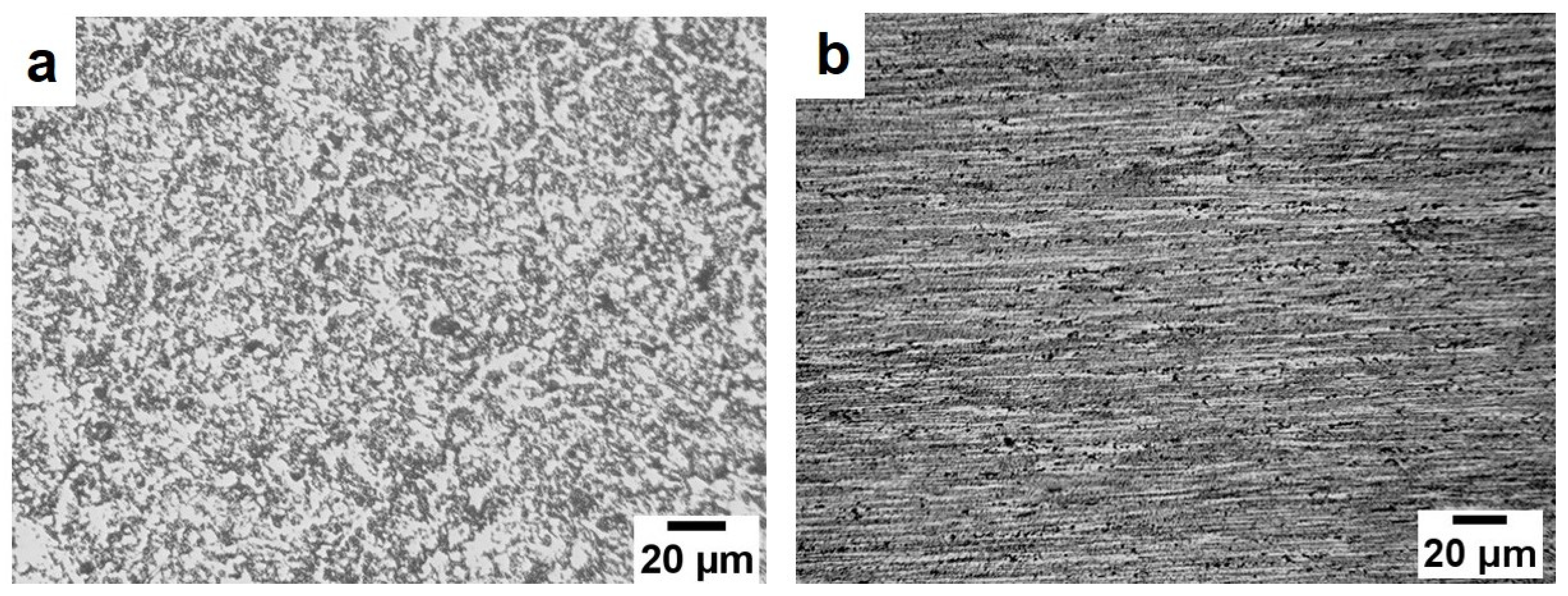

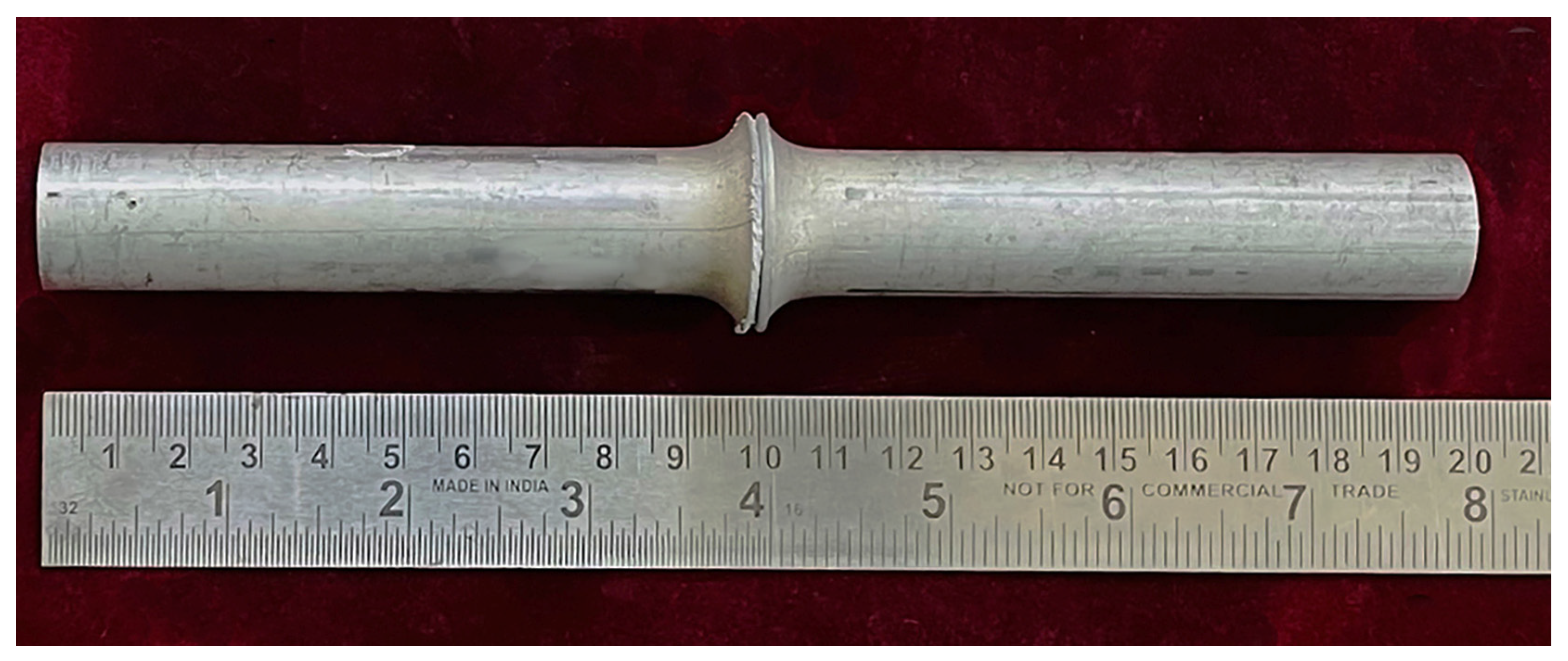
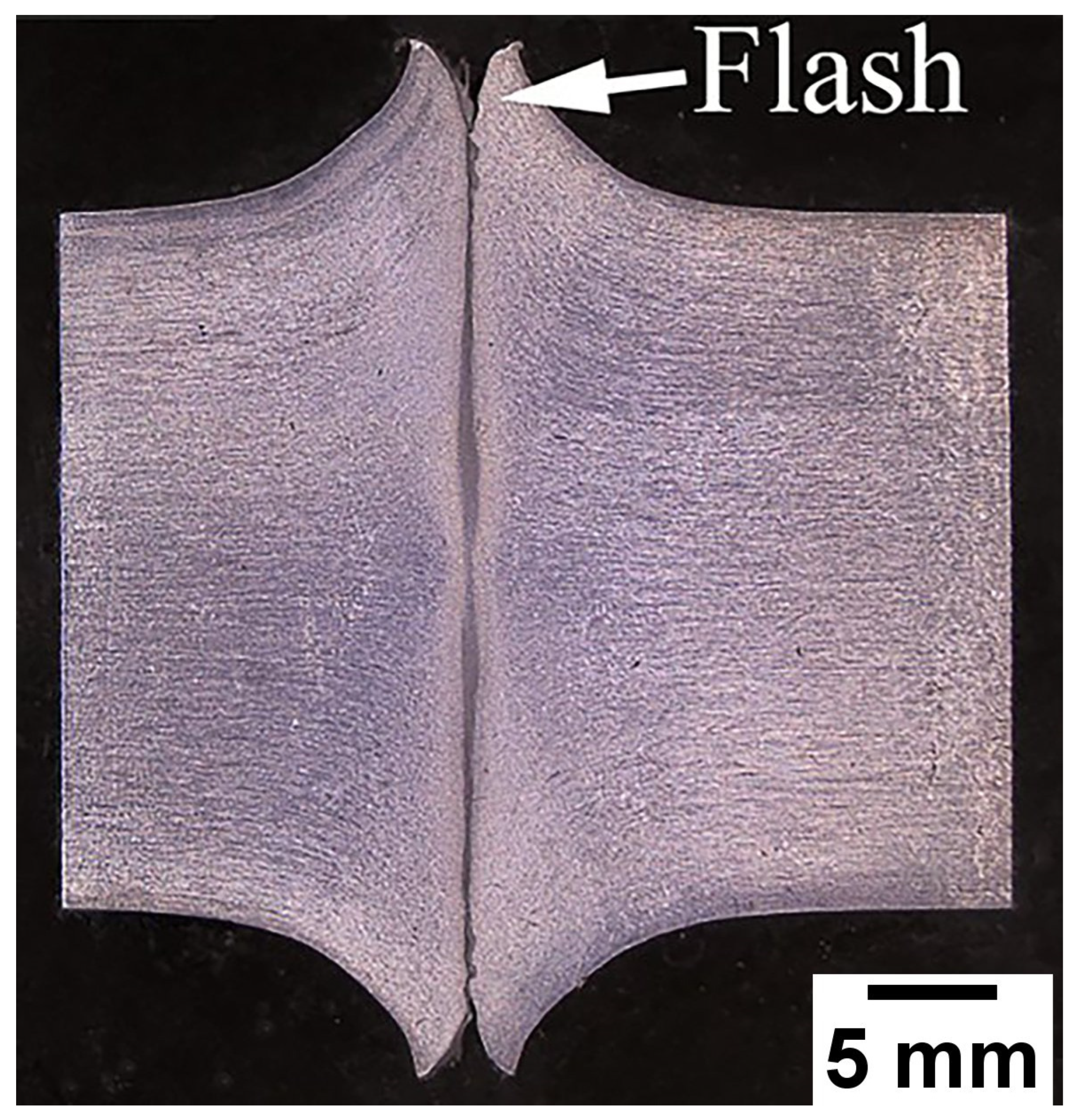



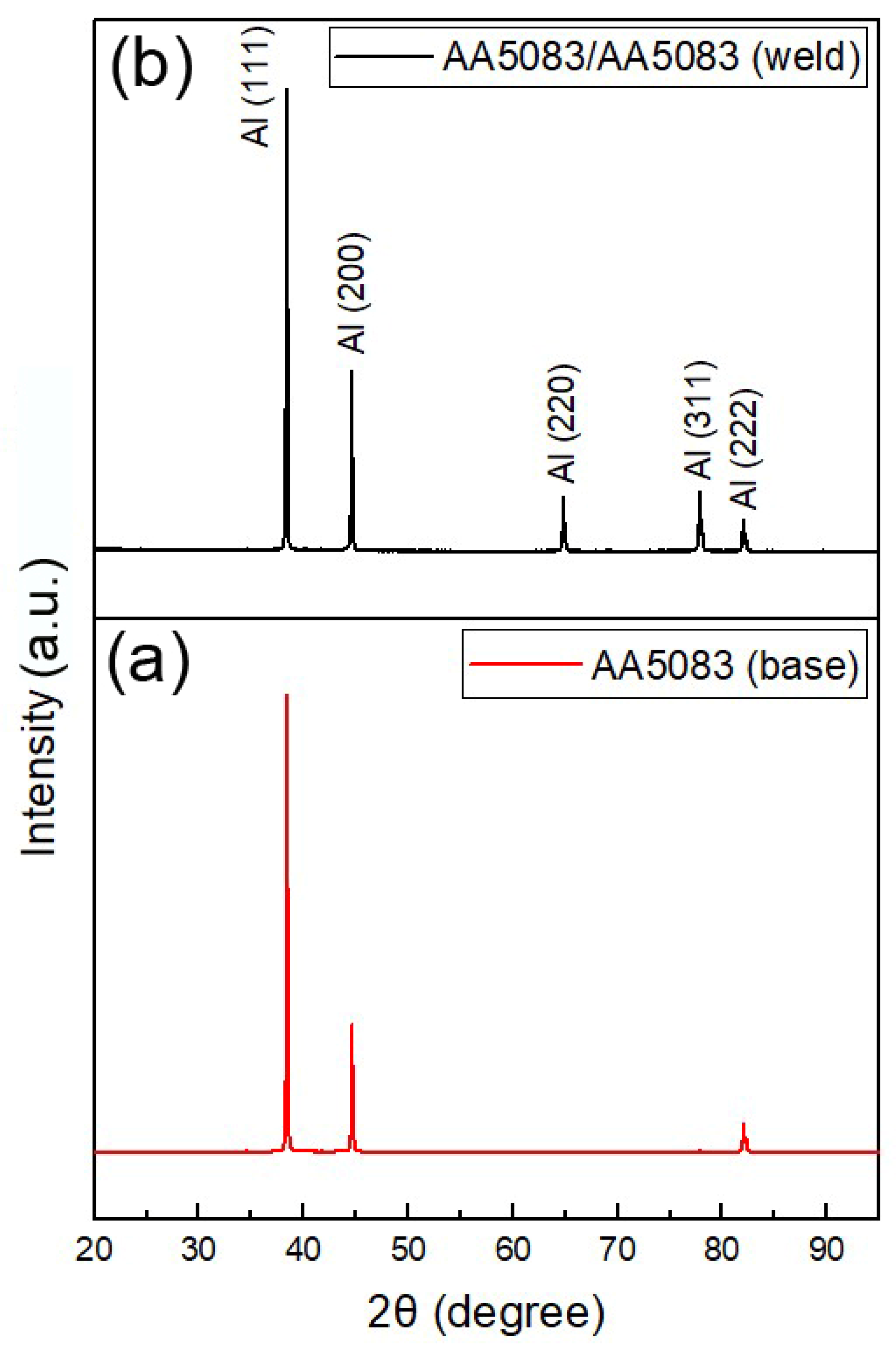



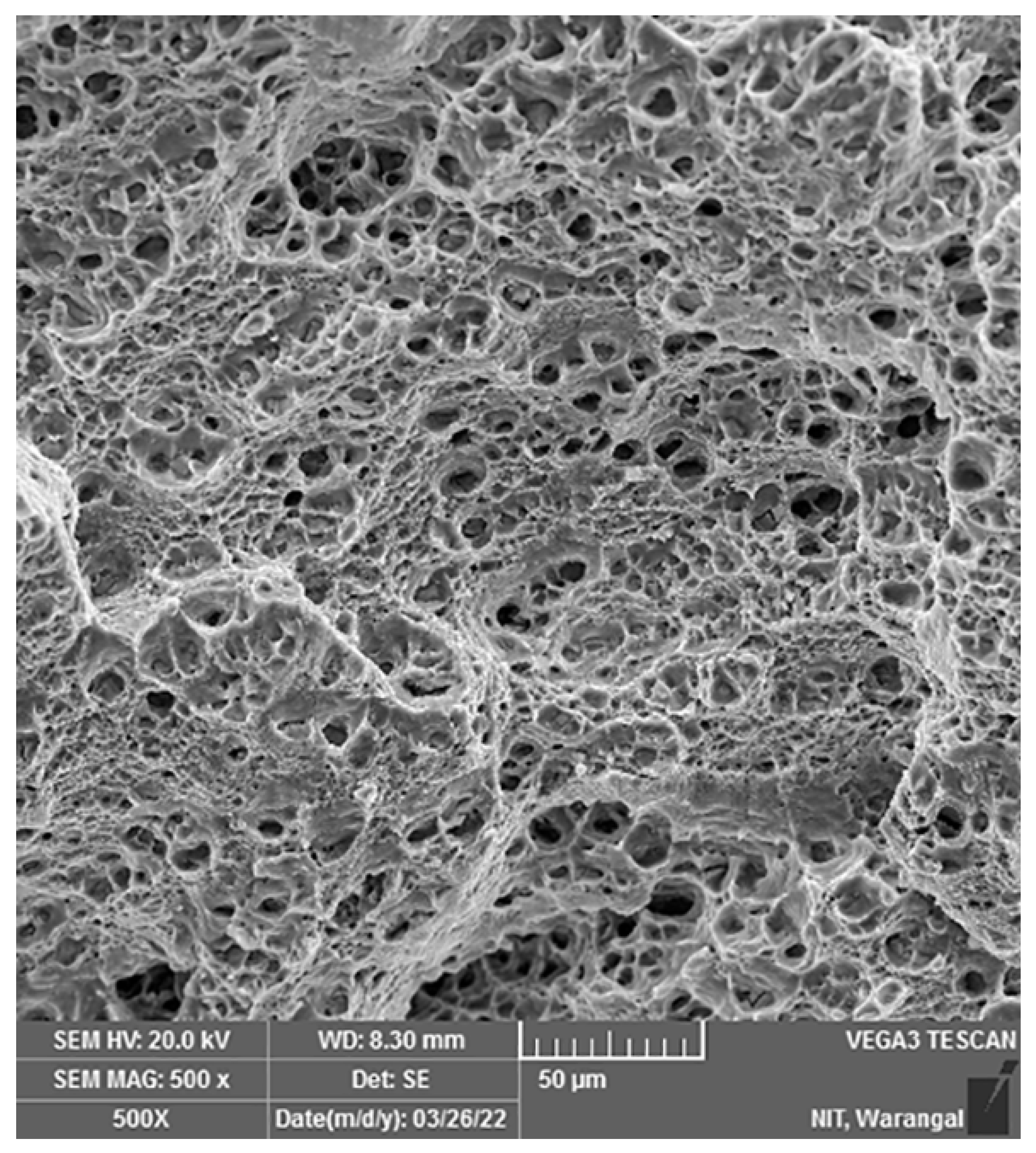
| Element | Zn | Mn | Mg | Cu | Cr | Fe | Si | Al |
|---|---|---|---|---|---|---|---|---|
| Wt. % | 0.11 | 0.53 | 4.9 | 0.03 | 0.09 | 0.27 | 0.04 | Bal |
| Parameters | Explored Ranges | Selected Values |
|---|---|---|
| Rotational speed (rev/min) | 1200–1400 | 1400 |
| Friction burn-off (mm) | 2–5 | 5 |
| Upset force (kN) | 19–24 | 24 |
| Soft force (kN) | (Constant) | 2 |
| Soft force time (s) | (Constant) | 4 |
| Friction force (kN) | (Constant) | 12 |
| Upset time (s) | (Constant) | 3 |
| Name | Yield Stress (YS), MPa | Ultimate Tensile Strength (UTS), MPa | % Elongation (El%) |
|---|---|---|---|
| AA5083/AA5083 (weld) | 301 ± 6 | 425 ± 7 | 13 ± 2 |
| AA5083 H116 (base) | 207 ± 5 | 385 ± 9 | 15 ± 3 |
Disclaimer/Publisher’s Note: The statements, opinions and data contained in all publications are solely those of the individual author(s) and contributor(s) and not of MDPI and/or the editor(s). MDPI and/or the editor(s) disclaim responsibility for any injury to people or property resulting from any ideas, methods, instructions or products referred to in the content. |
© 2023 by the authors. Licensee MDPI, Basel, Switzerland. This article is an open access article distributed under the terms and conditions of the Creative Commons Attribution (CC BY) license (https://creativecommons.org/licenses/by/4.0/).
Share and Cite
Mahajan, A.M.; Krishna, K.V.; Quamar, M.J.; Rehman, A.U.; Bandi, B.; Babu, N.K. Structure–Property Correlation between Friction-Welded Work Hardenable Al-4.9Mg Alloy Joints. Crystals 2023, 13, 1119. https://doi.org/10.3390/cryst13071119
Mahajan AM, Krishna KV, Quamar MJ, Rehman AU, Bandi B, Babu NK. Structure–Property Correlation between Friction-Welded Work Hardenable Al-4.9Mg Alloy Joints. Crystals. 2023; 13(7):1119. https://doi.org/10.3390/cryst13071119
Chicago/Turabian StyleMahajan, Aditya M., K. Vamsi Krishna, M. J. Quamar, Ateekh Ur Rehman, Bharath Bandi, and N. Kishore Babu. 2023. "Structure–Property Correlation between Friction-Welded Work Hardenable Al-4.9Mg Alloy Joints" Crystals 13, no. 7: 1119. https://doi.org/10.3390/cryst13071119







